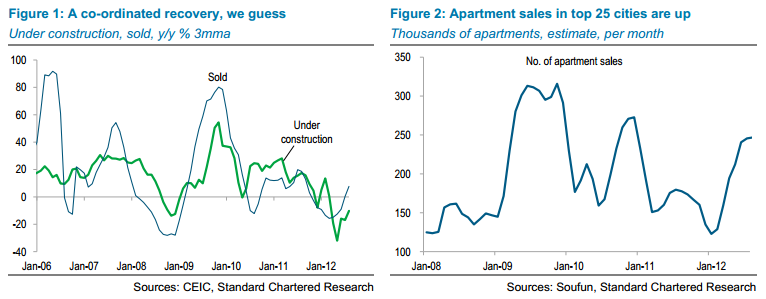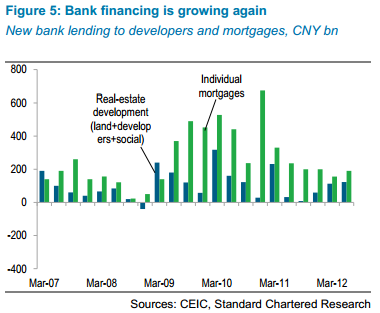
Cross-posted from FTAlphaville.
Remember Chinese property? How there was a boom in apartment building that amounted to some 10 per cent of GDP, and now there are gazillions of investment apartments sitting empty, and local governments got really hooked on the revenues from land sales, and it all fueled the development of weird and dodgy securitisationswhich offered a tempting alternative to letting one’s savings lose value in a deposit account?
Then in 2010 the government began introducing measures to dampen speculation in the bigger cities, and the whole thing began to slow down, leaving many local governments and developers somewhat worried.
But, as of the last three months or so, there has been something of an upturn. Morecities are recording price rises than price falls — a reversal of the late 2011 and early 2012 pattern. And Standard Chartered’s China strategists, who follow the sector quite closely, are fairly confident that is more than a dead cat bounce.
Standard Chartered noted a few months ago that there were a few signs that the property market might be stabilising after many months of downward drift. And lo, they have since found yet more signs. And those signs, when fed into Excel and spat out into charts with StanChart colours and logos, look like this:

Pretty interesting, right? (If you don’t think so, we suggest you look again. CLOSER. )
The report’s authors, Stephen Green, Lan Shen and Andy So, say that year-on-year apartment sales are back in positive territory, at least in the 25 tiers 1 to 3 cities they track, after eight months of decline. And there’s more:
More significantly, the decline in area under construction appears to have bottomed (there is considerable volatility in the numbers, so we plot the three-month moving average). This measure has been contracting for most of 2012, dragging on overall growth. But we believe it could well move back into positive territory in Q1-2013. At any rate, we believe that the worst of the contraction in construction growth is probably over.
Plus, the slowdown in building of new apartments has dramatically curtailed the problem of huge excess inventories, write Green, Lan and So.
In fact, they say, sales are picking up so much — and unit completion has been so slow — that inventory depletion could be a problem in the second half of 2013, at least in the top-tiered cities.
Meanwhile, land sales are holding steady and possibly rising (the local governments will be relieved), and financing appears to be easier:

Crikey.
The StanChart strategists warn that there are some risks — policy risks and the wider economy.
On policy, it’s worth remembering that the government was extremely concerned about high property prices boosting inflation and making home ownership unaffordable in the bigger cities — that’s what led to the restrictions on property investment. Plus, there is a big leadership transition taking place next month. So there are some unknowns.
And then there’s the economy:
A slower economy (meaning slower wage growth and falling household confidence, which may cause households to postpone home purchases). At a real-estate conference we attended in Beijing last week, developers were discussing the meaning of slightly weaker apartment sales numbers in some cities in the last two to three weeks, and asking whether slower economic growth was already having an impact. The downturn in the non-manufacturing PMI (to 53.7 in September) from above 55 in recent months suggests that the difficulties encountered by the industrial sector are now filtering through to the urban services sector.
Nevertheless, they are cautiously optimistic.

